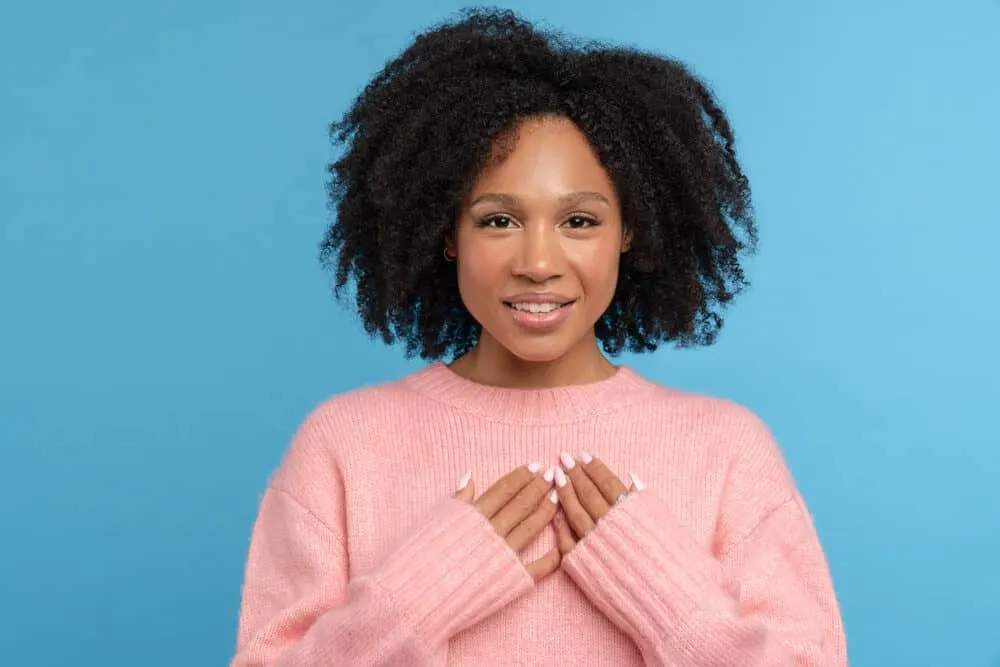
Curly natural hair is known for being extremely dry, requiring regular moisturizing sessions and ongoing care. If you’re new to caring for your natural hair, we’ll bet you’ve been asking yourself, “How often should I moisturize my natural hair?”
We’re glad to say that you’re in the right place. In this in-depth guide, we’ll answer this question and more to ensure that you’re well-equipped to care for your natural hair and ensure that your hair stays moisturized. Let’s start with the question, how often should you moisturize your hair?
Table of Contents
- 1 How Often Should You Moisturize Your Hair
- 2 What’s the Best Way to Moisturize Your Hair?
- 3 Can You Moisturize Your Hair Every Day?
- 4 Factors Affecting How Often You Should Moisturize Natural Hair
- 5 Frequently Asked Questions
- 5.1 How Often Should I Moisturize My 4c Hair?
- 5.2 Should You Moisturize Hair Everyday?
- 5.3 Can You Moisturize Your Hair Too Much?
- 5.4 Does My Hair Need Moisture or Protein?
- 5.5 What If My Hair Is in a Protective Style?
- 5.6 How Important Is Night-Time Care for Keeping Natural Hair Moisturized?
- 5.7 Related Articles
How Often Should You Moisturize Your Hair
You should moisturize your hair every 3-7 days, tailoring the frequency to your specific hair type and environmental factors. A more frequent moisturizing schedule benefits individuals with type 4 curls, known for their dryness. Use water or water-based moisturizers daily to every other day, especially in a climate with drastic weather changes. Seal the moisture with oils or creams to enhance retention.
If your hair is chemically treated or colored, intensify your moisturizing routine, incorporating deep conditioning treatments weekly. Adjust your regimen according to the season, as colder or drier months may demand increased hydration. Always observe your hair’s response and adapt your practices as needed.
Key Takeaways
- Moisturizing Frequency: As a general rule of thumb, you should moisturize your hair every few days (at least once per week). Some women will need to do it more often, while others can go longer between moisturizing sessions.
- Hair Porosity: Understand your hair’s porosity to tailor your moisturizing practices, ensuring effective absorption and retention of moisture.
- Seasonal Adjustments: Increase moisturizing efforts during dry seasons or drastic climate changes to maintain your hair’s health and manageability.
- Night-Time Care: Utilize satin, silk bonnets/scarves, or pillowcases at night to retain moisture, preventing dryness and brittleness.
- Protective Styles: Implement protective hairstyles and moisturize your hair effectively before and after styling to maintain flexibility and hydration levels.
Keep reading to learn how to maintain healthy hair and how often you’re supposed to moisturize your hair. You’ll also find a detailed step-by-step tutorial.
| Hair Type/Condition | Recommended Products/Treatments |
| Curly hair | Water-based moisturizers, coconut oil |
| Colored/Treated Hair | Leave-in conditioner, essential oils |
| Low Porosity | Hair mask, natural oils |
| High Porosity | Moisturizers, sealing oils |
| Braids/Protective Styles | Light oils/water mix, dry shampoo |
A moisturizing session can mean anything from spritzing your hair with water to doing a full-on moisturizing and sealing session with natural oils (more on this later).
You may think it is tedious to moisturize your hair so often, but the truth is that moisture and protein balance is the key to healthy natural hair.

What’s the Best Way to Moisturize Your Hair?
When it comes to moisturizing your hair, there are several options you can choose from, including deep conditioners, hot oil treatments, and many other techniques. Keep reading to find out about each one and how you can incorporate these hair products into your moisturizing routine.
Use Water or Water-Based Moisturizer and Leave-In Conditioner (Daily to Every Other Day)
H2O (or water) is the ultimate moisturizer for your natural hair – it helps bring life back to dull, dry, lifeless curls. You may find that your hair needs to be spritzed with water every day or so to remain moisturized.
A good leave-in conditioner is another way to add moisture to your natural hair and make it easier to manage throughout the day. It will help detangle (use a wide-tooth comb), reduce frizz, and define your curls. We recommend using a leave-in conditioner with water as the first or second ingredient.

Moisturize and Seal – Every Few Days to a Week
After using a hair moisturizer, it’s always best to seal in the moisture with oil, butter, or gel. We like using avocado oil, castor oil, olive oil, aloe vera gel, and shea butter, although there are many different oils and gels that you can use.
The process of moisturizing and sealing your hair is one of the most time-intensive ways to maintain moisture, being that it requires you to apply a hydrating product to slightly damp hair and then apply an oil on top.
Although at the same time, it’s also one of the most reliable ways to keep dry hair at bay. We recommend that you moisturize and seal once or twice per week to maintain healthy moisture levels.
You should also incorporate protein treatments as needed but avoid using too much protein. Creating the right balance is important. Click here to learn more about moisture and protein balance.
LOC Method
The LOC method is a deep moisturizing and sealing technique that’s very popular in the natural hair community. The acronym “LOC” stands for liquid, oil, and cream. When products are layered in this order, you can expect lasting moisture.
There are some variations to the LOC method. Some people prefer doing the LCO method, requiring a leave-in conditioner, cream, and then a sealing oil.
Try both methods to see which one works best for your hair. Everyone’s hair is different, so it’s important to try things for yourself and see how your hair reacts.

Squish to Condish
For curly hair that’s more prone to dryness, some ladies use a technique called squish to condish, where you apply conditioner (as a barrier) and use your hands to push water into your hair strands.
The squish-to-condish method, which is rapidly growing in popularity in the natural hair community, will hydrate and revitalize your naturally curly hair.
You start with your normal wash day routine with a sulfate-free shampoo (or co-wash regimen).
Then use a moisturizing product (e.g., conditioner) to detangle and eliminate knots, then you start the squish-to-condish process. Read this article to learn more.
Deep Condition – Every Week or So
You might be wondering about the difference between a leave-in conditioner and a deep conditioner. A leave-in conditioner is a product designed to provide light moisture, enhanced shine, and help with detangling.
A deep conditioner is a heavier treatment that provides deep moisture to thirsty strands – it also softens the hair and adds shine. Specialized conditioners also repair damaged hair with a dose of protein. Deep conditioning is a crucial step when your hair is overly dry and damaged.
You should aim to deep condition your hair 2-4 times a month. If your hair is extremely dry, you should deep condition it weekly. Also, some ladies incorporate a hot oil treatment into their moisture routine, which is also a great option.
Click here to learn more about hot oil treatments and how to use a natural moisturizer like avocado oil within your hair care regimen.

Can You Moisturize Your Hair Every Day?
You can certainly moisturize your hair every day, but you should only do so if your hair needs it. Most people may need a few spritzes of water every morning to keep their hair feeling soft and pliable.
Others don’t need to moisturize as often. It’s rare to be in a situation where you need to moisturize and seal your hair every day.
There is such a thing as moisture overload. It can cause your hair to feel limp and lose its ability to curl. It could also make your hair more difficult to style.
https://youtu.be/D2jKpWKldEc?si=VLtKeb6uIJde2GU9
Factors Affecting How Often You Should Moisturize Natural Hair
There are many factors to think about when determining how often you should moisturize your natural hair. The following sections will fill you in on all of them!
Moisturizing After Dying Your Hair or Chemical Processing
Colored or bleached hair requires a tedious moisturizing regimen because it has already been through a harsh chemical process that often leads to hair damage. Hair coloring and bleaching processes lift your hair’s cuticle, making it more susceptible to moisture loss.
If you’ve colored or bleached your hair, you’ll need to do weekly deep conditioning treatments and moisturize daily with hydrating leave-in conditioners. This will help your color-treated hair stay healthier and moisturized.
Hair Porosity
If your hair has low porosity, it means that you have tightly sealed cuticles impairing your hair’s ability to absorb moisture since it’s more difficult for water to penetrate your hair strands.
While everyone’s hair is different, all hair experiences porosity and permeability. The great thing about low porosity hair is that once it absorbs moisture, it holds onto it.
So, if you moisturize your low porosity hair as we suggested, you can likely go several days before you’ll need to moisturize it again.
If you have high porosity hair, the good news is that your hair easily absorbs moisture but does not necessarily retain it well, thanks to the missing or damaged cuticles.
For this porosity level, you need to ensure you seal in the moisture. This will keep your moisturizing and sealing sessions to a minimum.
Climate Affects Your Moisturizer
When you live in a place with drastic weather changes, it can negatively affect your natural hair. Extremely hot or cold temperatures cause your hair to dry out.
If you live in an area where dramatic temperature changes often occur, you will need to moisturize your hair more often. In severe cases, you may need to spritz your hair daily, deep-condition weekly, and do moisturizing and sealing sessions every few days.
Time of Year Changes Your Hair Care Needs
You may find yourself moisturizing your hair more or less often, depending on the season. For instance, in the spring, there may be more moisture in the air, prompting you to moisturize less. In the winter or summer, when it’s dry out, you’ll need to up your moisturizing sessions.
Night Protection
Cotton pillowcases absorb the moisture from your natural hair, leading to increased dryness and brittleness. If you don’t regularly protect your hair at night, this could make your hair more likely to be dry despite a good moisturizing routine.
Sleeping with a satin bonnet allows your hair to retain moisture better. We also encourage you to invest in silk or satin pillowcases.
Hairstyles
If your hair ends are rubbing against a cotton sweater or t-shirt throughout the day, they’re more likely to dry out more quickly compared to someone wearing a protective style wear their ends are protected.
We recommend wearing protective styles, but we understand that they’re not perfect for everyone. So, pay attention to your hair and moisturize as needed.
To learn more about protective hairstyles, read these articles:
- Protective Styles for a Black Girl’s Hair (i.e., usually type 3 and type 4 curly hair)
- Protective Styles for a White Girl’s Hair (i.e., usually type 1 and type 2 straight hair)
Frequently Asked Questions

How Often Should I Moisturize My 4c Hair?
We recommend moisturizing 4C hair (often called kinky coily hair) at least once every two days because coily hair is the most fragile curl type and requires more gentle care than other types of hair.
Should You Moisturize Hair Everyday?
You should moisturize your hair on an as-needed basis. If your hair feels dry, using a moisturizing spray (water-oil mix) or conditioner should help. The key takeaway is to moisturize your hair as needed based on your specific hair care needs, including daily if necessary.
Can You Moisturize Your Hair Too Much?
You can over-moisturize your hair, leading to protein loss and potential breakage. Excessive washing or moisturizing can cause your hair strands to weaken and cause hair damage.
Does My Hair Need Moisture or Protein?
To tell if your hair needs moisture or protein, take one of your hair strands and feel it to determine if it feels dry and rough. You can also stretch the hair strand to determine if it’s pliable. Does it stretch easily and bounce back, or does it break easily?
If your hair feels dry or breaks easily, you should use a moisturizing treatment. However, if your hair feels mushy or stretches and doesn’t bounce back, you might need a protein treatment.
What If My Hair Is in a Protective Style?
A general rule of thumb is to moisturize your natural hair every few days, with some ladies needing moisture more often depending on their personal needs. However, the purpose of moisturizing is to increase the flexibility of your natural hair.
If you are not manipulating your hair every day (i.e., wearing a protective style), you don’t necessarily need to moisturize as often when wearing a protective style. We do recommend moisturizing your hair when you’re creating the protective style and when you’re taking the style down.
While wearing the style, finding a good leave-in conditioner or moisturizer specifically designed for your needs is crucial. People who use heavy cream moisturizers and light oils/water mix (with a spray bottle) can alternate between the two to maintain their hair and scalp. Experiment with different products to determine what works best for your hair type.
How Important Is Night-Time Care for Keeping Natural Hair Moisturized?
Wrapping your hair prior to bedtime with a satin bonnet or silk scarf is a key component to ensuring your hair remains moisturized overnight. Some women also choose to sleep on a satin pillowcase, resulting in less dryness and brittleness.
- How To Moisturize Relaxed Hair Without Weighing It Down
- How to Hydrate Low-Porosity Hair
- How Often Should I Moisturize My Starter Locs
Keeping your hair well-hydrated and healthy, even for 4C and natural hair textures, can be easy. Olive and coconut oil are essential oils that can moisturize the hair shaft and cuticles. These oils moisturize and strengthen hair cuticles, protecting them from environmental stress. To meet specific needs, you can also use hair masks. They can revive fine hair and protect curls.
To keep your hair healthy, use heat protectants and limit your use of flat irons. Also, dry shampoo is an excellent option for cleansing without drying out your hair. It refreshes your tresses while keeping them moisturized. Follow these practices all day, even with braids or other protective styles. Your journey to radiant, moisturized hair is well within reach.
